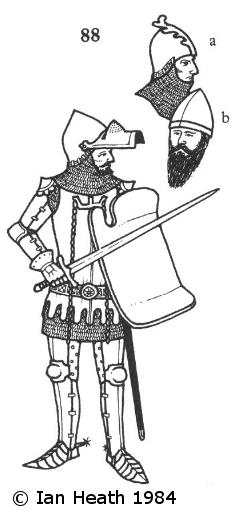
Register a SNAP EBT card with Amazon
HUNGARIAN MAN-AT-ARMS, 14th CENTURY
An extract from Armies of the Middle Ages, Volume 2by Ian Heath



88. HUNGARIAN MAN-AT-ARMS, 14th CENTURY
Again based principally on the 'Képes Krónika' frontispiece, this figure demonstrates that Hungarian men-at-arms of this period were basically indistinguishable from those of Germany; Otto of Freising wrote as early as the mid-12th century that Hungarian knights were beginning to adopt the arms and tactics of the crown's German mercenaries, and this trend had obviously continued. He wears a red brocade jupon over a mail haubergeon and a coat-of-plates, guard-chains attached to the latter being almost invariably left hanging free in this ms. rather than being attached to the sword and dagger as one would have expected. Other pictures show men-at-arms wearing just mail armour, comprised of haubergeon, chausses and aventail, plus plate gauntlets. The leg-harness depicted here includes studded leather cuisses plus latten poleyns. Arm-harness, however, is totally absent from this particular ms., though it occurs in most other contemporary Hungarian sources, from one of which that depicted here is taken. Instead most have three-quarter length mail sleeves, some in addition wearing leather pteruges at the shoulder.
This ms. and many other sources indicate that most Hungarian men-at-arms wore bascinets, more often than not without a visor; the visor shown here is therefore added from another source (a fresco of c. 1350). 88a depicts an alternative kind of bascinet, with an ornate strengthener over the forehead and crown, which occurs several times in the ms. and perhaps evolved from helmet-covers such as are described under figure 82. 88b is another detail from the same source, showing the kind of long beard to be seen worn by many Hungarian men-at-arms in 14th century pictures.
Hungarian men-at-arms are usually portrayed in the sources as being armed with lance and sword, but it is clear that the sabre was also popular, as were the war-hammer and the mace. In addition, it is apparent that according to traditional custom' noblemen were expected to bring even a bow and arrows with them to musters, even though there seems to be no evidence of bow-armed men-at-arms in contemporary sources. Probably the bow was used by a retainer, mounted or otherwise.
His bouched shield is one of 2 or 3 variants to be found in the sources, with the bottom edge square as here or rounded like that of 85, and with or without the bouché.